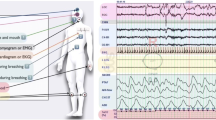Opinion statement
-
•Insomnia in the pediatric populations is very different than insomnia in the adult population. Although both involve sleeplessness, the causes vary significantly.
-
•Sleeplessness during early infancy is normal, and the developing sleep-wake pattern of an infant is inconsistent with the normal sleep-wake pattern of parents. Asynchrony of parental and infant sleep patterns can lead to specific complaints of sleeplessness in infants.
-
•Parental response to the infant’s developing sleep-wake pattern may be a factor that determines the presence (or absence) of problem sleeplessness as the child matures.
-
•Problem sleeplessness in children may result from behavioral, circadian, or biologic or medical abnormalities. Therefore, evaluation of the sleepless child should not be limited to only behavioral etiologies.
Similar content being viewed by others
References
American Psychiatric Association: Diagnostic and Statistical Manual of Mental Disorders, edn 4. Washington, DC: American Psychiatric Association; 1994.
Anders TF: Night-waking in infants during the first year of life. Pediatrics 1979, 63:860–864.
Palmer CD, Harrison GA, Hirons RW: Sleep patterns and life styles in Oxfordshire Village. J Biosoc Sci 1980, 12:437.
Law AL: California Assessment Program: Student Achievement in California Schools: 1979–1980, annual report. Los Angeles:1980.
FerberR: Sleeplessness in the child. In Principles and Practice of Sleep Medicine. Edited by Kryger MH, Roth T, Dement WC. Philadelphia: WB Saunders; 1989:633–639.
Ferber R: the sleepless child. In Sleep and its Disorders in Children. Edited by Guilleminault C. New York: Raven Press; 1987:141–163.
Ferber R, Boyle MP: Nocturnal fluid intake: a cause of, not treatment for, sleep disruption in infants and toddlers. Sleep Res 1983, 12:243.
Sheldon SH: Disorders of development and maturation of sleep, and sleep disorders in infancy, childhood and cerebral palsy. In Sleep Disorders and Neurological Disease. Edited by Culebras A. New York: Marcel Dekker; 2000:59–81.
Sheldon SH, Spire JP, Levy HB: Pediatric Sleep Medicine. Philadelphia: WB Saunders; 1992.
Jacobs IN, Gray RF, Todd NW: Upper airway obstruction in children with Down Syndrome. Arch Otolaryngol Head Neck Surg 1996, 122:945–950. Sleep-related breathing problems in children with congenital or genetic disorders of the midface or mandible are common. This article provides important knowledge regarding obstructive sleep apnea syndrome in Down syndrome. It also exemplifies the issue of the presence of comorbid states (eg, hypotonia and midface defects).
American Sleep Disorders Association: International classification of sleep disorders, revised: diagnostic and coding manual. Rochester: American Sleep Disorders Association; 1997.
Ferber R: Circadian rhythm sleep disorders in childhood. In Principles and Practice of Sleep Medicine in the Child. Edited by Ferber R, Kryger M. Philadelphia: WB Saunders; 1995:91–98.
Klein T, Martens H, Kijk DJ, et al.: Circadian sleep regulation in the absence of light perception: chronic non-24-hour circadian rhythm sleep disorder in a blind man with a regular 24-hour sleep-wake schedule. Sleep 1993, 16:333–343.
Sack RL, Keith D, Lewy AJ: Circadian rhythm abnormalities in totally blind people: incidence and clinical significance. J Clin Endocrinol Metab 1992, 75:127–131.
Webb WB: Are short and long sleepers different? Psychol Rep 1979, 44:259–264.
Ferber R: Solve Your Child’s Sleep Problems. New York: Simon and Schuster; 1985:55–80.
Bell C, Simon D, Sovick J: Formulary Handbook: Children’s Memorial Hospital, edn 4. Hudson: Lexi-Comp; 1999.
Subcommittee on Pharmacy and Therapeutics: Formulary of Accepted Drugs: University of Chicago Hospitals, 1999. Hudson: Lexi-Comp; 1999.
Benitz WE, Tatro DS: Pediatric Drug Handbook, edn 3. St. Louis: Mosby; 1995.
JanJ, Espenzel H, Appleton RE: The treatment of sleep disorders with melatonin. Dev Med Child Neurol 1994, 36:97–101. This article by Jan and colleagues will become a classic. Few studies of melatonin and its effectiveness in children have been published, and this study involves a relatively large number of children treated with melatonin. Much can be learned from this seminal investigation.
Sheldon SH: Proconvulsant effects of oral melatonin in neurologically disabled children. Lancet 1999, 351:1254. Few studies have reported side effects or adverse reactions to melatonin. This open label trial of melatonin in neurologically challenged children showed a significant increase in seizure activity with melatonin use. It reveals a profound need for further study and evaluation of melatonin in treatment of sleeplessness.
Author information
Authors and Affiliations
Rights and permissions
About this article
Cite this article
Sheldon, S.H. Insomnia in children. Curr Treat Options Neurol 3, 37–50 (2001). https://doi.org/10.1007/s11940-001-0022-9
Issue Date:
DOI: https://doi.org/10.1007/s11940-001-0022-9




